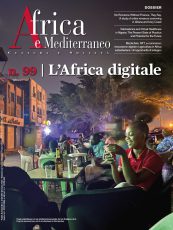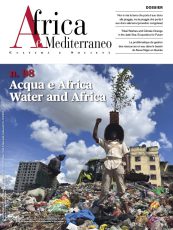Acqua e Africa | Water and Africa
Africa e Mediterraneo n. 98 (1/23)
Acqua e Africa | Water and Africa
Africa e Mediterraneo n. 98 (1/23)
Photo cover: Artist and activist Stoneface Bombaa standing atop a pile of trash in Nairobi wearing one of his Tree Helmets, part of his Nomadic Forest Installation. Bombaa created the installation as part of his Future Forest Ritual meant to engage his community around the issue of deforestation and regreening the community he lives in, Mathare, an informal settlement in Nairobi. © Kairos Futura
Water is one of the epistemological foundations of global thinking about Africa, being one of the filters that orient the knowledge and narrative of those who look(ed) at Africa from other shores. Spanning literature, mythology, photography, journalism, and all the hard sciences, water shapes the ways in which we produce knowledge about the continent. Water played a leading role in the birth and survival of glorious civilizations and tragic colonial exploits; it transported and swallowed millions across the Black Atlantic; it created the ecosystems now endangered by climate change. Water returns as an identifying element of the African continent even, and perhaps even more powerfully, when it is missing: the deserts – once a symbol of the borders of the “civilized” world –stand out majestically in all their aridity, the outpost of the leones, that “otherness” that first justified, and then accelerated, colonization in its old and very current forms.
In this respect, it is a signifier that encapsulates many of the asymmetrical aspects of the North’s relationship with that part of the global South. Migration containment policies, so relevant today in our country, insist on the dangers caused by a permanent occupation of Mediterranean waters by the thousands who try to cross it. We are told that “our” world and well-being depend on our ability to patrol and secure that body of water. The militarization of Mare Nostrum is yet another tool of the real and metaphorical appropriation of an African “liquidity” that is imagined as resistant to control and discipline. In that sense, water is once again instrumental in preserving the us VS them dichotomy and taking agency away from the “other.” It takes on political connotations, becoming a fundamental element of being or not being in the world.
But to speak of water in relation to Africa entails also tracing the transformations of local and global political agendas in the face of climate change and its impact on populations and territories across the plant. Some areas of the continent already suffer from a shortage drinking water, a condition that, if not adequately mitigated, will spread to ever larger territories in a very short time, with unpredictable consequences. For example, according to the United Nations, by 2025 North Africa will be classified as a water-poor region. The World Water Conference held in New York in March of this year established the urgent need for all countries of the world to commit themselves to preserving freshwater reserves and increase initiatives aimed at achieving Sustainable Development Goal number 6, which seeks to ensure the availability and sustainable management of water and sanitation for all. The African countries participating in the conference also signed up to the action agenda, the program of voluntary initiatives to mitigate drinking water shortages via the development of alternative food systems that reduce water consumption in agriculture. For several years now, many local and international projects have already been working towards these goals by building water extraction, purification and desalination infrastructures, educating the population and new generations in the sustainable use of water resources. The examples are countless – from investments in seawater desalination in Egypt to investments to improve access to fresh water in Burkina Faso to the inauguration of sewage treatment plants in Kenya – and they all show that writing about water and Africa today is more pressing than ever and necessary to put the challenges of our changing world into perspective.
The contributions collected in this issue of the journal address the theme of water from different angles and geographical positions. The first four deal with African literatures. Francesca Romana Paci examines the theme of fresh water in English and French fiction by African and non-African authors, who have had a long relationship with Africa. The result is an extensive and in-depth overview in which water emerges as a recurring theme, though rarely a prominent one, often evoked as a metaphor for human experience and its problems. Marco Fazzini devotes his attention to the work of the South African Douglas Livingstone, a poet and scientist who studied water pollution off Durban all his life. His work combines, in a unique and original way, the objective gaze of the scholar and the subjective one of the poet, resulting in a multifaceted and heartfelt picture of the marine ecology of the South African coast, imbued, especially in recent years, with great ecological drive and concern for the future of its waters. The altering effects of the anthropic imprint on the land and climate change return in Jessica Falconi’s article that focuses on the novels of the Angolan authors Pepetela and Luandino Vieira and the Mozambican João Borges Coelho. In these works, water and its material representations channel a critical view of the historical turning points and the often traumatic changes that have taken place in Angola and Mozambique since independence. Giving voice to nature, the authors place it at the heart of a multiform, complex and non-anthropocentric environment, where human and non-human elements coexist in a difficult balance constantly endangered by the colonialism, neo-colonialism and neo-liberalism. Finally, Mina M. Đurić proposes an interpretation of water, and more precisely rain, in Africa in the literary production of the 1930s, introducing the writings of Serbian authors Rastko Petrović and Jelena Dimitrijević. Đurić interprets water as a sur-literary trope that can bring world literature back to a global dimension. Her article discusses how writing about water unites different cultures in the constitution of the specific roots of today’s global literature.
This is followed by three articles that frame water through the lenses of sustainability and community. Elena Giacomelli and Pierluigi Musarò examine the relationship between the sea, climate crisis, and migration in Senegal. The waters of the Atlantic Ocean represent both a risk and a promise for the people who, after having lived off fishing for centuries, now deal with the impoverishment of the water, caused in large part by the exploitation of American and Asian multinational fish companies, and contemplate the need to migrate elsewhere. For the Senegalese, as for millions of others in the Global South, the journey is precluded, and so the illegal crossing, aboard unsafe boats, becomes the only solution, and more and more often the Ocean that promises freedom and prosperity turns into a grave. Mattia Fumagalli describes the drying up of Lake Turkana – the world’s largest and most alkaline lake, also known as Jade Sea – and its effects on the balance of the surrounding areas, where the disappearance of the basin threatens the peaceful coexistence between the nomadic Turkana pastoralists and the Dassanech people, who live along the border between Kenya and Ethiopia. Armed clashes have increased and so have population movements. Despite being the subject of numerous protection and cooperation programs, water, from being a bearer of life, is also becoming a cause of destabilization and death. Fumagalli explores the human-environment relationship in a rapidly deteriorating context, emphasizing the resilience of the populations involved. Mohamed Sacko presents a case study on the environmental degradation of the Niger River in Guinea, a country that is hydrographically rich but whose population is still little aware of the problems of environmental destruction and human pollution. On the basis of interviews, observations and literature analysis, the author proposes solutions for the sustainable management of this important resource that can reconcile development needs with the needs of the populations living along its course, duly made aware of the need to preserve the river ecosystem.
The last four contributions are historical. Luigi Gaffuri describes the travel accounts of the Italian missionaries in Sudan Angelo Vinco and Stanislao Carcereri, looking at the geographical and hydrological elements that emerge from their accounts, particularly those on the evangelization of the population. In these documents, water plays a strategic function, becoming the most precious resource among those offered by nature. Monica Labonia and Mamadou Lamine Sané lay out the geographical similarities between the sites of the Muslim shrines called “Keñekeñe jáaméŋ” in Gunjur and Kafountine, introducing a new analytical element in the study of the Senegalese Tijâniyya brotherhood. Both shrines are located near fresh water, an element that seems to have guided the original choice of the confraternity’s founder, El Hadj Omar Tall. Fresh water is also a characteristic element of the rituals suggested to pilgrims wishing to visit the holy sites. Emanuele Oddi traces the history of the Great Ethiopian Renaissance Dam, one of Africa’s largest hydroelectric infrastructures. His article correlates the Medieval tradition whereby Ethiopian rulers had the power to divert the course of the Blue Nile with modern events related to the Dam, concluding that today the Nile has lost its ancient status as a symbol of peace and prosperity for all, fueling international tensions and internal clashes. Ettore Morelli discusses the writings of members of the African Auxiliary Pioneer Corps recruited by the British Empire to fight in the Mediterranean during World War II, focusing on the shipwreck of the Erinpura. This episode – which occurred off the coast of Libya in 1943 and caused the death of hundreds of auxiliaries from modern-day Botswana, Lesotho, and eSwatini – inspired lyrical compositions that are still little known and studied in Italy, the country where many of the survivors fought for the liberation from Nazifascism.
Following are three testimonies from the continent. Jama Musse Jama writes critically about the world’s indifference to the drought that, aggravated by climate change, has gripped a vast region of the Horn of Africa for the past six years. The famine affecting almost two million Somalis triggers food insecurity and depopulation, triggering chain effects that, while having global repercussions, crash against a wall of silence from the international institutions that could help mitigate them. The Kenyan art collective Kairos Futura, interviewed by the editorial staff, illustrates the “Nairobi Space Station” project in some informal neighborhoods in Nairobi, where the population draws water from polluted sources. Nairobi Space Station is a project of civic education on ecological responsibility based on a creative and zero-impact methodology to make the inhabitants of those areas aware of the risks associated with the consumption of non-purified water, later providing them with easy-to-implement tools to verify the quality of the resource. Paolo Agostini writes about the oases in Tunisia where desertification threatens socio-economic and ecological survival. His article describes the “Les Oasis de El Ouidane” project, which has equipped the oasis of Degache in the south-west of the country with tools for separate waste collection and a composting site. The latter has an immediately positive impact on the soil it enriches, counteracting the effects of desertification and protecting the palm grove that is at the heart of local life.
Finally, for the “Museums” section, Claudio Arbore presents the project of the Memorial da Escravatura e do Tráfico negreiro in Cacheu, Guinea-Bissau. The museum was created with the intention of promoting local development, focusing on the region’s cultural heritage that is intimately linked to the history of the Black Atlantic. A cultural economy project, initiated by a local NGO and supported by European Union development cooperation programs, which creates a place of memory and a new awareness of identity, especially among the many schoolchildren who visit it, while also have a positive economic impact on the area.
ABSTRACT







